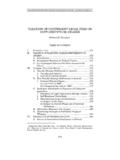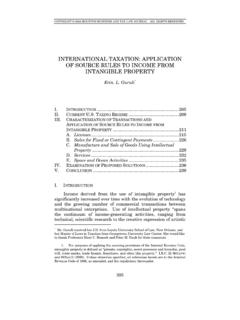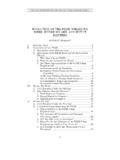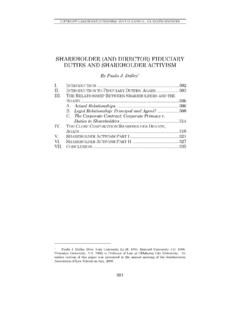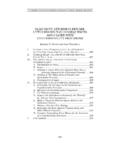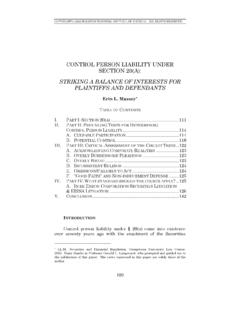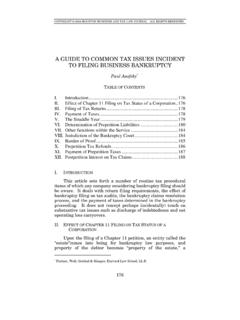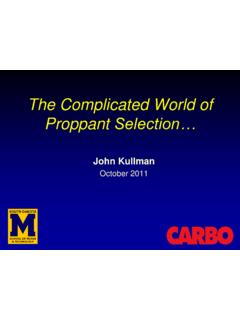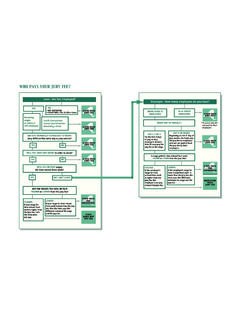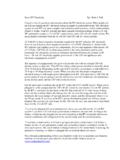Transcription of MEASURING BUSINESS DAMAGES IN FRAUDULENT …
1 COPYRIGHT 2011 HOUSTON BUSINESS AND TAX LAW JOURNAL. ALL RIGHTS RESERVED 1 MEASURING BUSINESS DAMAGES IN FRAUDULENT INDUCEMENT CASES By George P. Roach* I. SUMMARY .. 2 II. INTRODUCTION .. 3 III. SUMMARY CHARACTERISTICS OF FRAUDULENT INDUCEMENT .. 7 A. damage Preliminaries .. 10 B. FRAUDULENT Inducement Widens the Plaintiff s Reach .. 12 IV. THE EVOLUTION OF DAMAGES LAW FOR FRAUDULENT INDUCEMENT .. 14 A. The Standard of Practice Since 1980 .. 17 B. Expectancy DAMAGES .. 19 C. Perry Equipment .. 22 D. Reliance Waivers and Class Actions .. 26 V. VALUE AS A DAMAGES METRIC .. 27 A. MEASURING Value .. 28 B. Valuation Date .. 32 VI. LOST PROFITS AS A DAMAGES METRIC .. 34 A. Mitigation .. 39 B. Are Lost Profits Always Special DAMAGES ?.. 41 C. Gross Not Net Profits .. 42 D. Ex Post v. Ex Ante Evidence .. 43 VII. BOB V. OOP APPROACHES TO DIRECT DAMAGES .. 44 A. Asset Transactions .. 44 B. Service Contracts .. 48 C. Expectancy Claims In BUSINESS Acquisitions.
2 52 D. Disconnected Values .. 55 VIII. SPECIAL DAMAGES .. 58 IX. RELIANCE DAMAGES .. 63 X. EQUITABLE REMEDIES .. 67 XI. AVOIDING OR MINIMIZING THE MINEFIELD .. 71 XII. CONCLUSIONS .. 72 * George Roach practices DAMAGES law and provides consulting on litigation DAMAGES and valuation in Dallas, Texas. He is a Senior Adviser to the litigation consulting firm of Freeman & Mills, Inc. in Los Angeles. His background includes an , and an in economics. See for further information. COPYRIGHT 2011 HOUSTON BUSINESS AND TAX LAW JOURNAL. ALL RIGHTS RESERVED 2 HOUSTON BUSINESS AND TAX LAW JOURNAL [Vol. XI I. SUMMARY In litigation, damage claims should be dynamic: a party s strategy for maximizing or minimizing the expected remedy should influence discovery and pleading tactics. Similarly, DAMAGES strategy should be formulated with the goal of optimizing the DAMAGES award in light of the known facts and most likely rulings on the elements required to prove or disprove the case.]
3 Texas case law in FRAUDULENT inducement, however, does not reflect much strategy as there appears to be significant confusion about the applicable legal requirements for proving DAMAGES . In many cases, the parties seem less focused on optimizing their cases than trying to survive an obstacle course or minefield. This article will analyze and discuss how remedies and DAMAGES are structured and measured in claims for FRAUDULENT inducement relating to corporate transactions. Sections III and IV will summarize the basic structure for damage claims in FRAUDULENT inducement. Section III discusses the basic characteristics of the cause of action, including the many remedies available as well as the capacity to name defendants that would otherwise be difficult to reach. Section IV will review the evolution of Texas case law relating to MEASURING DAMAGES for FRAUDULENT inducement.
4 It will show how the standard of practice has evolved over time and explain the nature of the judiciary s long-standing concern about excessively speculative measures. Sections V to XI provide more of a strategic view in the analysis of key issues for damage claims. Sections V and VI analyze the use of value and lost profits, respectively, as measures of expectancy DAMAGES . Section VII examines the differences between the two major approaches to direct DAMAGES and how the choice between alternative approaches can be affected by one s election to accept or deny the contract and the nature of the contract. Examples are provided of case opinions that have confused this issue and of valuation findings that are disconnected with the case facts in general. Special DAMAGES and reliance DAMAGES are discussed in Sections VIII and IX, focusing mainly on how the choice of approach to direct DAMAGES can exclude certain special DAMAGES and how some special DAMAGES can be duplicative.
5 Section X summarizes possible equitable remedies and how they can sometimes provide unique solutions to particular problems in the litigation process. Finally, Section XI briefly suggests how such litigation can be avoided altogether COPYRIGHT 2011 HOUSTON BUSINESS AND TAX LAW JOURNAL. ALL RIGHTS RESERVED 2011] MEASURING BUSINESS DAMAGES 3 or, if unavoidable, how some of the more obvious risks can be minimized. II. INTRODUCTION Defending against a claim for FRAUDULENT inducement in Texas is like walking through a minefield without a reliable map; one misstep could result in the financial equivalent of losing an arm or a leg. The analogy may apply as well to plaintiffs or even judges who are not immune from harm or embarrassment in this area of litigation. Their confusion about the location of the mines can result in avoidable reductions in jury awards or reversals of court holdings for the lawyer or judge, respectively.
6 Each participant can be at risk. Defendants to consumer claims of FRAUDULENT inducement have suffered severe damage awards. For example, a builder who constructed a home in 1984 for $641,000 was found to have tried to obscure a defective The jury awarded and court of appeals affirmed $550,000 for reasonable repairs, $107,000 for loss of market value after the repairs, $111,000 for legal fees, $300,000 for mental anguish, and $1,000,000 for punitive Defendants to corporate claims can also be vulnerable to large jury awards. In a case that was later reversed, an agricultural insecticide distributor claimed that a financial partner ruined his BUSINESS and his plans to manufacture feedstock chemicals by refusing to release about $200,000 of internally generated The jury awarded $ million of lost The court of appeals found insufficient evidence to affirm the finding as the plaintiff had no experience in manufacturing chemicals and its distribution BUSINESS was operating at a large Plaintiffs face a risk6 that jury findings will be reversed as the Texas judiciary continues to fret over the potential that large 1.
7 Carpenter v. Holmes Builders, Inc., No. 11-02-00132-CV, 2004 LEXIS 1649, at *25 (Tex. App. Eastland Feb. 19, 2004, pet. denied) (not designated for publication). 2. Id. at *17 3. Barnes v. Cumberland Int l Corp., No. B14-93-00086-CV, 1994 LEXIS 2011, at *5-6 (Tex. App. Houston [14th Dist.] Aug. 11, 1994, writ denied) (not designated for publication). 4. Id. at *6. 5. Id. at *10-11. 6. Statements in this article about the relative frequency of any holding have not been statistically proven and should be viewed as anecdotal or based on impression. There can be no assurance that the article is based on all relevant case opinions or a representative sample of all relevant case opinions. To be fair, however, there can be no COPYRIGHT 2011 HOUSTON BUSINESS AND TAX LAW JOURNAL. ALL RIGHTS RESERVED 4 HOUSTON BUSINESS AND TAX LAW JOURNAL [Vol. XI damage awards in claims for FRAUDULENT inducement will overwhelm other causes of action, and that impressionable juries may accept excessively speculative measurements of plaintiffs DAMAGES .]
8 Perhaps these two concerns explain why two thirds of the relevant Texas Supreme Court opinions have reversed or remanded the damage issues: five cases were affirmed,7 five were remanded for trial or reconsideration,8 and in eight cases the DAMAGES were denied Lawyers are exposed in multiple areas. First, law firms may find themselves defendants to FRAUDULENT inducement claims even in the absence of privity with the Second, plaintiffs lawyers have to explain to their clients why the jury finding was overridden or remanded, how the jury instructions were defective, or why certain key pieces of evidence were omitted. Not surprisingly, corporate clients can get upset about these damage issues. For example, in one breach of contract case, the corporate plaintiff could not accept the small damage award even though the contract at issue waived consequential and punitive That plaintiff then sued his legal team for legal malpractice on the damage issues, but lost at both the trial and appellate assurances that the full population of case opinions on any one issue is necessarily representative of how that issue is treated at the trial level.
9 Perhaps the true import of such case statistics to a litigator can be summarized by paraphrasing a quote sometimes attributed to Joseph Stalin about casualties in war: one reversal is a tragedy; one million reversals is a statistic. See Joseph Stalin Quotes, , http:// (last visited Mar. 26, 2011). 7. Trenholm v. Ratcliff, 646 927, 933 (Tex. 1983); White v. Sw. Bell Tel. Co., 651 260, 263 (Tex. 1983); Kish v. Van Note, 692 463, 466, 468 (Tex. 1985); Henry S. Miller Co. v. Bynum, 836 160, 162-63 (Tex. 1992); and Tony Gullo Motors I, v. Chapa, 212 299, 303, 314 (Tex. 2006). 8. Arthur Andersen & Co. v. Perry Equip. Corp., 945 812, 817 (Tex. 1997); Formosa Plastics Corp. v. Presidio Eng rs & Contractors, Inc., 960 41, 51 (Tex. 1998); Waite Hill Servs. v. World Class Metal Works, 959 182, 184 (Tex. 1998); Fortune Prod. Co. v. Conoco, Inc., 52 671, 682 (Tex.)
10 2000); and Aquaplex, Inc. v. Rancho La Valencia, Inc., 297 768, 775-76 (Tex. 2009). 9. Woods v. Littleton, 554 662, 664 (Tex. 1977); Leyendecker & Assocs., Inc. v. Wechter, 683 369, 373-74 (Tex. 1984); Bankston Nissan, Inc. v. Walters, 754 127, 128 (Tex. 1988); Fed. Land Bank Ass n v. Sloane, 825 439, 442-43 (Tex. 1991); , Inc. v. Hillsboro Indep. Sch. Dist., 973 662, 664 (Tex. 1998); Haase v. Glazner, 62 795, 800 (Tex. 2001); Baylor Univ. v. Sonnichsen, 221 632, 637 (Tex. 2007); Stuart v. Bayless, 964 920, 921-22 (Tex. 1998). 10. McCamish, Martin, Brown & Loeffler v. Appling Interests, 991 787, 791 (Tex. 1999). 11. Cont l Holdings, Ltd. v. Leahy, 132 471, 472 (Tex. App. Eastland 2003, no pet.). 12. Id. COPYRIGHT 2011 HOUSTON BUSINESS AND TAX LAW JOURNAL. ALL RIGHTS RESERVED 2011] MEASURING BUSINESS DAMAGES 5 The Texas judiciary faces hazards of its own, both real and perceived.

